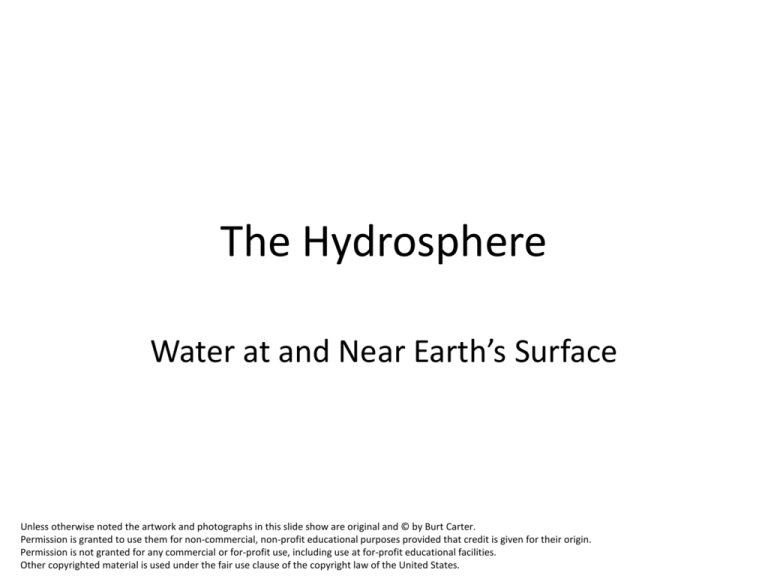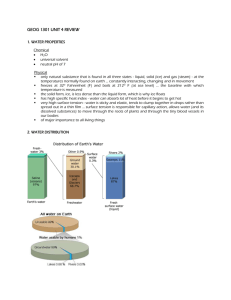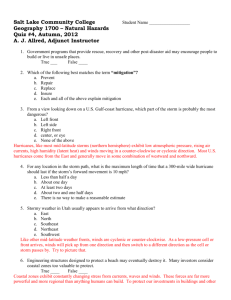The Hydrosphere
advertisement

The Hydrosphere Water at and Near Earth’s Surface Unless otherwise noted the artwork and photographs in this slide show are original and © by Burt Carter. Permission is granted to use them for non-commercial, non-profit educational purposes provided that credit is given for their origin. Permission is not granted for any commercial or for-profit use, including use at for-profit educational facilities. Other copyrighted material is used under the fair use clause of the copyright law of the United States. Water at and near Earth’s surface occurs in several forms (liquid, vapor, and ice) and places (atmosphere, underground, oceans, streams, lakes) and moves freely among both the phases and the places. The mechanisms by which it moves are referred to as the hydrologic cycle. In its simplest form the hydrologic cycle is very simple: water moves from Earth’s surface into the atmosphere as vapor, condenses, then falls back to Earth as either water (rain) or ice (snow, mainly, but also sleet and hail). However, each part of that simple system is a little more complex and we need to examine them at this level. We begin with vaporization to the atmosphere. Simple evaporation is the primary way that water vapor is moved into the atmosphere. Because oceans cover a little over 70% of Earth’s surface, most of the vapor comes from them. (Note that it is pure fresh water that evaporates, the dissolved salts remain in the ocean and rain is always fresh.) On land, evaporation occurs from lakes, rivers, and directly from the soil, but since only a tiny fraction of the water on Earth is on land, only a tiny amount is lost this way. A miniscule amount of vapor is lost as ice in glaciers and snowpack transform directly to vapor in a process called sublimation. Sublimation from glaciers & snowpack Evaporation of soil moisture Evaporation from lakes and streams Evaporation from oceans The other major mechanism for moving vapor to the atmosphere is called transpiration. It is really just a glorified version of evaporation, but brings water from some distance below the ground to be evaporated. The undersides of leaves have many small openings called stomata (the singular version is stomate). The openings are flanked by a pair of cells called “guard cells. When there is plenty of water available to the tree through its roots, and when the weather is warm, the guard cells tighten up and open the stomate (A). When water is scarce and the temperature too hot they relax and close the cell. The open stomata allow evaporation from the cells within the leaf to the atmosphere and this causes a cascade of events that brings more water, dissolved nutrients, and dissolved ions to the leaf. A B The water and ions that move up the plant through the xylem in response to transpiration are ultimately taken up by the roots from the ground. Tree roots routinely grow to a depth of 4+m (~15 feet) if the soil allows it. The maximum observed depth of a root was ~7 m (23 feet). Even a lowly carrot grows a extensive root system to ~2.5m (7 feet), and alfalfa to over 3m (10+ feet). This brings soil water from much deeper than simple evaporation is capable of bringing it, and that water evaporates at a prodigious rate. An acre of corn (with roots penetrating 1.5-2.5m – 4-7 feet) can transpire as much as 4000 gallons of water per day in the hottest part of summer. A single mature oak tree in a temperate forest can transpire 40,000 gallons of water a year, mostly in the hottest part of summer. The maximum observed daily rate was over 1000 gallons per day. Given that a mature oak forest can have several hundred trees per acre, such an acre forest can transpire hundreds of thousands of gallons of water per day. The Great Smoky Mountains are called that for all the water vapor haze in the air, not for real smoke. What happens to the vapor once it is in the atmosphere? Water vapor in the atmosphere condenses back to the liquid state when it gets cool enough. Usually this occurs when it is an a rising air mass. The air mass may forced upward as a colder air mass pushes beneath it (cold front) or as it moves toward and over a colder air mass (warm front). Localized low pressure centers like thunderstorms and hurricanes also force air to rise, as do mountains in the path of a moving air mass. (Remember the idea of a “rainshadow” desert.) Collectively the water that falls after condensation makes big enough packages of water to fall is called precipitation. If the surrounding atmosphere is cold enough the precipitation might be frozen in the form of snow, sleet, or hail. If the air is too warm for frozen precipitation then the water falls as a liquid and is called “rain”. (Some rain never reaches the surface before reevaporating. This is called virga. And so the simplest version of the hydrologic cycle is this: Evapotranspiration puts water vapor into the air and … Condensation and precipitation return it to Earth’s surface … (repeat indefinitely.) The water on the surface is interesting to us because it plays a major role in most of the surface processes we talked about earlier and because we humans use it for so many things. So we will spend a little time thinking about how it occurs. Frozen precipitation that reaches the surface can have one of two fates: it can remain frozen “indefinitely” or it can melt fairly quickly and become liquid water. We will talk about what happens when it melts later. For now we will be interested in that part that remains frozen. Ice can fall on land on in the ocean. Most that falls in the ocean melts fairly quickly except near the poles in winter time when it can become incorporated into sea ice. Thus is remains frozen for at least that winter. Sea ice never builds to any great thickness – a few meters at most. Presently there is extensive permanent sea ice in the Arctic ocean and less in the Antarctic seas because they are more connected to the other oceans and have more dynamic waves and currents. The amount of permanent Arctic sea ice is rapidly decreasing now and it’s safe to say that any particular snowflake that falls in the Arctic this winter will only be frozen for a few years at most. If the surrounding atmosphere is cold enough the precipitation might be frozen in the form of snow, sleet, or hail. If the surrounding atmosphere is cold enough the precipitation might be frozen in the form of snow, sleet, or hail. Frozen precipitation that falls on land can also either stay frozen or melt, but if it stays frozen it may do so for millennia, not a few years. Most frozen precipitation is snow so we will talk about snow, but sleet and hail can have the same fates. Most snow that falls on land melts within a few days to a few months and becomes liquid water. In very high latitudes and high altitudes snow may persist from year to year without ever accumulating into a thick enough mass to recrystallize. This is called snowpack. At even higher altitudes and latitudes the snow does reach great thickness and as it accumulates the growing weight of snow near the top compresses the underlying snow to form a granular ice called firn a few 10’s of centimeters within the pile, and solid glacial ice even deeper. (Glacial ice has a coarsely crystalline texture like marble, and like marble is actually a metamorphic rock. An alpine or valley glacier on the side of a high mountain slips flows down hill under the direct influence of gravity. Ice accumulates in the upper elevations, but melting at the downhill end (or breaking to form icebergs if the glacier ends at the ocean) means total loss of ice there. In a continental glacier like those on Greenland and Antarctica the ice also moves, but much more slowly. Gravity is still the motive force, but the “hill” down which it pulls the ice is just the thickness of the ice itself. The ice, in other words, flows from the thickest part of the ice (usually nearest the center of the landmass) to the edges. 100’s of miles 10’s of miles Still, it may take centuries for an ice molecule that falls on the upper end of the glacier to move to the terminus and melt. Meanwhile it has been replaced by more ice falling every winter. Thus we say that water is stored in glacial ice for extended periods … as long as there are glaciers. Presently alpine glaciers are losing ice at their termini faster than it is replaced in the mountains. Thus, the glaciers are shrinking – most of the ones that existed in the USA when I was a child are now gone or are tiny. There is less slippage of the ice in these great ice sheets, and all that occurs is near the terminus. Most of the movement is like that of silly putty, only very slowly because it is very very cold silly putty. The ice near the center and at the base has only a directly downward gravitational force on it, and may never have moved at all. This means that in Antarctica, at least, the ice may have been stored for tens of millions of years now! (The oldest ice actually sampled so far is only about 900,000 years old.) Rain that falls over the ocean (or frozen precipitation that melts there) will sit until it re-evaporates, returning to the atmosphere again. An average water molecule is expected to stay in the ocean for 3000 years or a little more, though that figure varies greatly depending on whether the molecule gets into the deep ocean or stays near the surface. Virga, of course, returns immediately to the atmosphere and is never part of the surface water portion of the cycle. If the air is too warm for frozen precipitation then the water falls as a liquid and is called “rain”. (Some rain never reaches the surface before re-evaporating. This is called virga. The liquid rain (and any meltwater from frozen precipitation and glaciers as well) that falls to land can have two fates. If the air is too warm for frozen precipitation then the water falls as a liquid and is called “rain”. One possibility (and the most obvious to humans) is runoff – water moving downhill across the land surface (sheetwash) or in streams (channelized flow). This water may be temporarily stored in lakes, indeed, people dam rivers to make artificial lakes for exactly that purpose – to hold the water in a localized place for a longer time, so it can be exploited. (The Colorado River has so many impoundments on it that in most years no water reaches its mouth!) Most runoff eventually finds its way to the ocean, but some streams drain into closed depressions on land – Death Valley, Great Salt Lake, Dead Sea, etc.) If the air is too warm for frozen precipitation then the water falls as a liquid and is called “rain”. The other possible fate is called infiltration. Through the soil, through the bottoms of streams and lakes, or into cracks or caves in otherwise solid rock the water seeps into open spaces in the ground and becomes groundwater. (We say that infiltration recharges the groundwater.) This groundwater moves slowly down slopes and may also reach the ocean while still underground. Alternately it may come back to the surface at a pond or stream and return to the runoff phase of the cycle that way. If it does return to the surface we call the place it does so a spring. Some springs are very obvious, others are almost unnoticeable – the water simply leaks out of tiny cracks, or from in between sand grains, for example. Groundwater (Springs) Even at the ocean the movement of water by waves and tides creates interesting landscapes. Cliff retreat 10’s of meters Where sediment supplied to the coast by streams is scarce an erosional coast forms. Seacliff Mass Wasting Sea Level Wave-cut notch Wave-cut platform Wave Base Barrier Island Where sediment supplied to the coast by streams is adequate A depositional coast – a barrier island system – forms. (Old dunes) Bay (“Sound”) or Marsh Meters Dunes Beach Sea Level The shoreline of a landmass is not really the edge of the ocean. To a geologist and “ocean” is quite deep and is underlain by a particular type of crust. Remember that this crust is composed of mafic rocks, primarily basalt. An “Atlantic” or “Passive” continental margin looks like this and has these parts: Shore The shelf break is the edge of the shelf, where the slope steepens The wide continental shelf is the flooded continental crust The continental slope is the steep drop-off into the ocean proper 10’s of km CONTINENT Continental Crust (granitic) OCEAN The continental rise is an “apron” of shelf-derived sediment that has washed off the shelf and built outward onto the oceanic crust. Oceanic Crust (basaltic) Unlike the Atlantic, the Pacific Ocean is rimmed with active continental margins. Active margins look like this and have these parts: A volcanic arc with many active volcanoes little or no continental shelf Sea Level OCEAN Continent (or Island) A very deep narrow trench, often 5 or more times deeper than the main ocean floor a zone of fault movements cause numerous earthquakes in this region, beneath the arc and continent (Indications are that this is a piece of oceanic crust forced beneath the continental edge.) Regardless of the types of continental margins at the edges of an ocean, each ocean has at least one mountain chain on its floor, often right in the middle of the ocean, called a ridge. The flat seafloor on either side of the ridge, extending to the continental margins in both directions, is called the abyssal plain. (It appears in the previous two diagrams.) Sea Level (Mid) Ocean Ridge RIFT Abyssal Plain Oceanic Crust (basaltic) Abyssal Plain A central rift – a deep canyon – runs the entire length of the ridge, right down its middle. This rift is the scene of both intense fault movement (generating earthquakes) and basaltic volcanism. Indeed, though the entire oceanic crust is basaltic, only in the rift do any active volcanoes occur! The basalt does not escape the rift and flow outward to make the oceanic crust. Something more interesting happens, and we will return to it later. See if you can identify the ridges and trenches/volcanic arcs on this map. (Remember that a trench is always accompanied by an arc.) Then identify which continental margins are active and which are passive. Map © National Geographic Society. Used under fair use clause of copyright law. So the hydrologic cycle is a lot more interesting than just vapor up and water down. The surface water can be involved in lots of interesting processes: glaciers carving spectacular mountain scenery, rivers creating huge canyons or meandering streams, or deltas, soaking into the ground (from where we can extract it for agriculture or city uses), springing from the ground and making pretty swimming holes, cutting away at seacliffs to make rugged, scenic coasts like in Maine or California, or moving sand along the shore to make barrier islands and beaches. And the edges of the continents and bottoms of the oceans are also fascinating places. It can even be interesting by failing to provide rainfall in some places – around the 30° latitudes, for example, creating deserts with their spectacular scenery.







